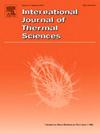Experimental study on flow and heat transfer characteristics of lead-bismuth eutectic in circular tube under solidification condition
IF 4.9
2区 工程技术
Q1 ENGINEERING, MECHANICAL
International Journal of Thermal Sciences
Pub Date : 2025-05-26
DOI:10.1016/j.ijthermalsci.2025.110019
引用次数: 0
Abstract
Lead-bismuth eutectic possess a high melting point and have the potential to solidify in critical components of the reactor during fast reactor operation, thereby creating additional thermal resistance and affecting normal reactor operation. In order to study the effect of this phenomenon, an experimental study was carried out on the flow and heat transfer characteristics of LBE when solidification phenomena occur during flow. With solidification, the experimental results demonstrated that the overall Nu decreased by approximately 19.5 %–62.5 % in comparison with the Nu under normal operating conditions (Pe: 986–2767). Furthermore, the solidification phenomenon leads to a 132.84 %–1277.05 % of increase in Eu. The distribution and morphology of solidified LBE in the steady state demonstrate that different cooling conditions alter the thickness of solidified LBE and the solidification initiation position, and affect the surface roughness of solidified LBE. The findings demonstrate that the presence of solidified LBE layer hindered the heat transfer between LBE and the wall, and leading to an additional pressure drop. Furthermore, the flow of lead-bismuth eutectic is also affected by the differing surface morphology of solidified LBE layer.
凝固条件下圆管内铅铋共晶流动及传热特性的实验研究
铅铋共晶具有高熔点,在快堆运行过程中有可能在反应堆的关键部件中固化,从而产生额外的热阻,影响反应堆的正常运行。为了研究这种现象的影响,对流动中出现凝固现象时LBE的流动和传热特性进行了实验研究。实验结果表明,随着凝固的进行,总体Nu比正常工况下(Pe: 986-2767)的Nu降低了约19.5% ~ 62.5%。凝固现象导致Eu含量增加132.84% ~ 1277.05%。稳态凝固LBE的分布和形貌表明,不同的冷却条件改变了凝固LBE的厚度和凝固起始位置,并影响了凝固LBE的表面粗糙度。结果表明,凝固的LBE层的存在阻碍了LBE与壁面之间的传热,导致了额外的压降。此外,不同的LBE凝固层表面形貌也会影响铅铋共晶的流动。
本文章由计算机程序翻译,如有差异,请以英文原文为准。
求助全文
约1分钟内获得全文
求助全文
来源期刊

International Journal of Thermal Sciences
工程技术-工程:机械
CiteScore
8.10
自引率
11.10%
发文量
531
审稿时长
55 days
期刊介绍:
The International Journal of Thermal Sciences is a journal devoted to the publication of fundamental studies on the physics of transfer processes in general, with an emphasis on thermal aspects and also applied research on various processes, energy systems and the environment. Articles are published in English and French, and are subject to peer review.
The fundamental subjects considered within the scope of the journal are:
* Heat and relevant mass transfer at all scales (nano, micro and macro) and in all types of material (heterogeneous, composites, biological,...) and fluid flow
* Forced, natural or mixed convection in reactive or non-reactive media
* Single or multi–phase fluid flow with or without phase change
* Near–and far–field radiative heat transfer
* Combined modes of heat transfer in complex systems (for example, plasmas, biological, geological,...)
* Multiscale modelling
The applied research topics include:
* Heat exchangers, heat pipes, cooling processes
* Transport phenomena taking place in industrial processes (chemical, food and agricultural, metallurgical, space and aeronautical, automobile industries)
* Nano–and micro–technology for energy, space, biosystems and devices
* Heat transport analysis in advanced systems
* Impact of energy–related processes on environment, and emerging energy systems
The study of thermophysical properties of materials and fluids, thermal measurement techniques, inverse methods, and the developments of experimental methods are within the scope of the International Journal of Thermal Sciences which also covers the modelling, and numerical methods applied to thermal transfer.
 求助内容:
求助内容: 应助结果提醒方式:
应助结果提醒方式:


